Effectiveness assessment in e-commerce is crucial for understanding business performance and driving growth. By evaluating metrics such as sales figures, customer retention, and conversion rates, businesses can gain valuable insights into their operations. Additionally, implementing engagement strategies like personalized marketing and social media interactions can enhance customer loyalty and boost overall sales.
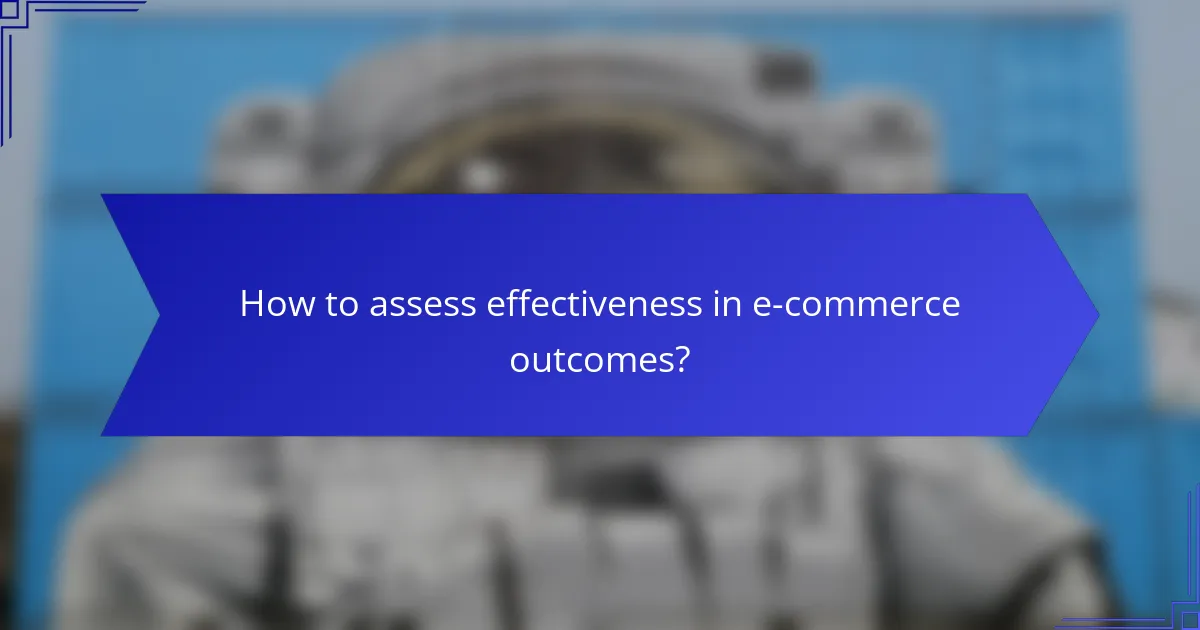
How to assess effectiveness in e-commerce outcomes?
Assessing effectiveness in e-commerce outcomes involves evaluating various metrics that reflect business performance, customer engagement, and growth potential. Key areas of focus include sales figures, customer retention, and conversion rates, which provide insights into how well an online store is performing.
Key performance indicators (KPIs)
Key performance indicators (KPIs) are essential metrics that help gauge the success of an e-commerce business. Common KPIs include revenue per visitor, average order value, and cart abandonment rate. Monitoring these indicators allows businesses to identify trends and areas needing improvement.
To effectively use KPIs, set specific targets based on historical data and industry benchmarks. Regularly review these metrics to adjust strategies and optimize performance. For instance, if the cart abandonment rate exceeds industry averages, consider enhancing the checkout process to reduce friction.
Sales growth metrics
Sales growth metrics provide insights into the overall health of an e-commerce business. These metrics include year-over-year growth, monthly sales trends, and sales by product category. Understanding these figures helps businesses identify which products are performing well and which may need more marketing support.
To assess sales growth effectively, compare current sales data against previous periods and industry standards. A healthy growth rate typically ranges from 10% to 30% annually, depending on the market and product type. Consistently tracking these metrics allows for timely adjustments to sales strategies.
Customer retention rates
Customer retention rates measure how well an e-commerce business keeps its customers over time. A high retention rate indicates customer satisfaction and loyalty, which are crucial for long-term success. Businesses should aim for retention rates of 60% to 80%, depending on the industry.
To improve retention, focus on customer engagement strategies such as personalized marketing, loyalty programs, and excellent customer service. Regularly analyze feedback and purchasing behavior to tailor your offerings and enhance the customer experience.
Conversion rates
Conversion rates reflect the percentage of visitors who complete a desired action, such as making a purchase. A typical conversion rate for e-commerce sites ranges from 1% to 3%, but this can vary widely based on the industry and target audience. Improving conversion rates is essential for maximizing revenue from existing traffic.
To enhance conversion rates, optimize website design, streamline the checkout process, and use persuasive product descriptions. A/B testing different elements, such as call-to-action buttons and page layouts, can provide valuable insights into what resonates best with your audience.

What engagement strategies drive growth?
Engagement strategies that effectively drive growth focus on creating meaningful interactions with customers. By leveraging personalized marketing, social media engagement, and targeted email campaigns, businesses can enhance customer loyalty and boost sales.
Personalized marketing campaigns
Personalized marketing campaigns tailor messages and offers to individual customer preferences and behaviors. This approach can significantly increase conversion rates, as customers are more likely to respond to content that resonates with their specific interests.
To implement personalized campaigns, utilize customer data to segment your audience. For example, you might create different promotions for first-time buyers versus repeat customers. Tools like CRM software can help manage and analyze this data effectively.
Social media interaction
Social media interaction fosters community and builds brand loyalty through direct engagement with customers. Regularly responding to comments, sharing user-generated content, and hosting live events can enhance your brand’s visibility and strengthen customer relationships.
Consider creating a content calendar to maintain a consistent posting schedule. Engaging with followers through polls, Q&A sessions, or contests can also encourage participation and increase your reach across platforms like Instagram and Facebook.
Email marketing effectiveness
Email marketing remains a powerful tool for driving customer engagement and retention. By sending targeted emails that provide value, such as exclusive offers or informative content, businesses can keep their audience engaged and informed.
To maximize effectiveness, segment your email list based on customer behavior and preferences. A/B testing subject lines and content can help identify what resonates best with your audience. Aim for a consistent sending frequency, such as weekly or bi-weekly, to maintain engagement without overwhelming subscribers.
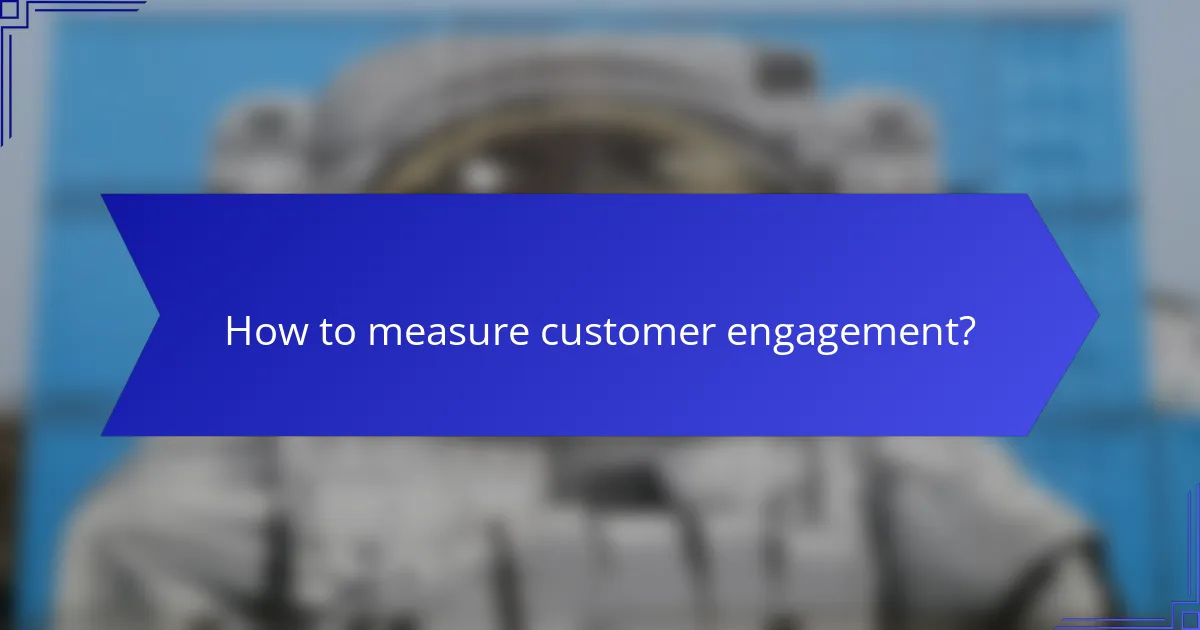
How to measure customer engagement?
Measuring customer engagement involves assessing how actively customers interact with your brand. Key metrics include customer feedback scores, engagement rates, and overall satisfaction, which provide insights into customer loyalty and areas for improvement.
Net Promoter Score (NPS)
Net Promoter Score (NPS) gauges customer loyalty by asking how likely customers are to recommend your product or service to others. Responses are typically rated on a scale from 0 to 10, categorizing customers into promoters, passives, and detractors.
A higher NPS indicates stronger customer loyalty, while a lower score suggests areas needing attention. Regularly tracking NPS can help identify trends and measure the impact of changes made to improve customer experience.
Customer Satisfaction Score (CSAT)
Customer Satisfaction Score (CSAT) measures how satisfied customers are with a specific interaction or overall experience. Typically, customers rate their satisfaction on a scale from 1 to 5 or 1 to 10, with higher scores indicating greater satisfaction.
CSAT is useful for pinpointing specific areas of improvement, such as product features or customer service interactions. To ensure accurate results, ask for feedback shortly after the customer experience and analyze trends over time.
Engagement rate analytics
Engagement rate analytics track how often customers interact with your content, products, or services. This can include metrics like click-through rates, social media interactions, and time spent on your website.
To calculate engagement rates, divide the total interactions by the total audience size, then multiply by 100 to get a percentage. Monitoring these rates helps identify which content resonates most with your audience and informs future marketing strategies.
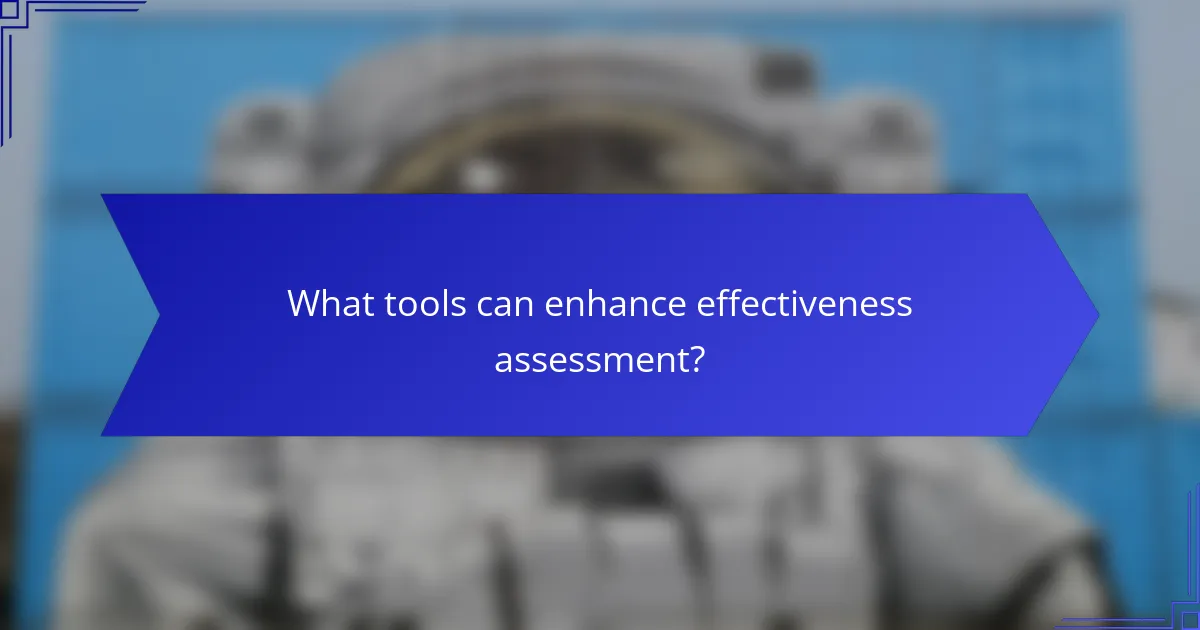
What tools can enhance effectiveness assessment?
Several tools can significantly improve effectiveness assessment by providing insights into outcomes, engagement, and growth. Utilizing the right software can streamline data collection, enhance analysis, and facilitate informed decision-making.
Google Analytics for e-commerce
Google Analytics is essential for e-commerce effectiveness assessment, offering detailed insights into user behavior, traffic sources, and conversion rates. By tracking key metrics such as average order value and cart abandonment rates, businesses can identify areas for improvement.
To maximize its benefits, set up e-commerce tracking within Google Analytics and regularly review reports to understand customer journeys. This allows for targeted marketing strategies that can boost sales and enhance user experience.
HubSpot for engagement tracking
HubSpot provides comprehensive engagement tracking tools that help businesses monitor customer interactions across various channels. It allows for the analysis of email open rates, click-through rates, and social media engagement, giving a holistic view of customer engagement.
Utilizing HubSpot’s CRM features can help segment audiences and personalize communication, which often leads to higher engagement levels. Regularly assess engagement metrics to refine marketing strategies and improve customer relationships.
Tableau for data visualization
Tableau is a powerful data visualization tool that transforms complex data sets into clear, interactive dashboards. This facilitates easier interpretation of effectiveness assessment data, allowing stakeholders to identify trends and make data-driven decisions.
When using Tableau, focus on creating visualizations that highlight key performance indicators relevant to your goals. This can help in presenting data to stakeholders in an understandable format, ensuring that insights lead to actionable strategies for growth.
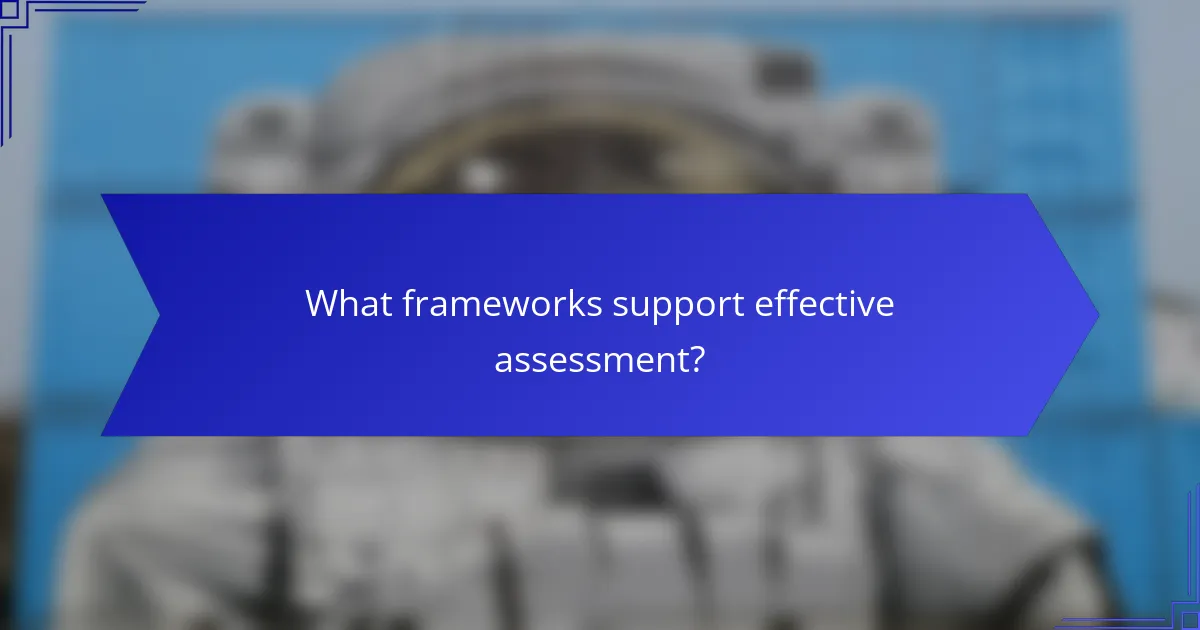
What frameworks support effective assessment?
Effective assessment relies on structured frameworks that guide goal setting, tracking progress, and evaluating outcomes. Two widely recognized frameworks are SMART criteria and OKR methodology, which help organizations clarify objectives and measure success.
SMART criteria for goal setting
SMART criteria stand for Specific, Measurable, Achievable, Relevant, and Time-bound. This framework ensures that goals are clear and attainable, which enhances focus and accountability. For example, instead of setting a vague goal like “improve sales,” a SMART goal would be “increase sales by 15% in the next quarter.”
When applying SMART criteria, consider the following tips: ensure your goals are specific to your team’s capabilities, set measurable indicators to track progress, and establish a realistic timeline. Avoid setting overly ambitious targets that may lead to frustration.
OKR methodology for tracking
The OKR (Objectives and Key Results) methodology is a goal-setting framework that connects individual performance to broader organizational objectives. It typically involves defining a few key objectives and measurable results that indicate progress towards those objectives. For instance, an objective could be “enhance customer satisfaction,” with key results like “achieve a 90% satisfaction rate in surveys.”
To implement OKRs effectively, focus on setting 3-5 objectives per cycle and ensure that key results are quantifiable. Regular check-ins can help maintain alignment and adjust strategies as needed. Avoid overloading your team with too many objectives, as this can dilute focus and hinder performance.
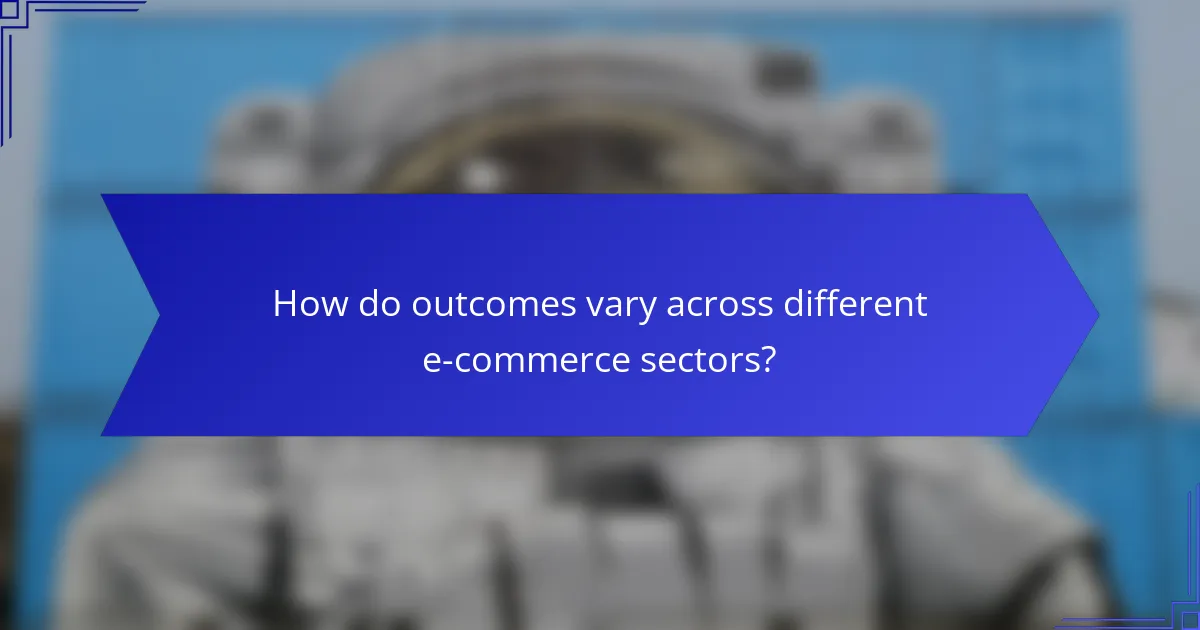
How do outcomes vary across different e-commerce sectors?
Outcomes in e-commerce sectors can differ significantly based on industry dynamics, target audiences, and product types. Each sector has unique performance metrics that influence engagement and growth strategies.
Fashion industry performance metrics
The fashion industry often measures success through metrics such as conversion rates, average order value (AOV), and customer retention rates. These indicators help brands understand how effectively they attract and retain customers.
For instance, a typical conversion rate in the fashion sector ranges from 1% to 3%, while AOV can vary widely, often falling between $50 and $150. Brands should focus on optimizing their online presence and marketing strategies to improve these metrics.
Common pitfalls include neglecting mobile optimization and failing to leverage social media for brand engagement. To enhance performance, fashion retailers should regularly analyze customer feedback and adapt their offerings accordingly.